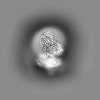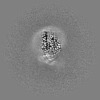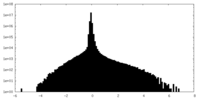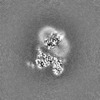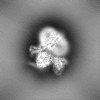登録情報 データベース : EMDB / ID : EMD-43647タイトル CryoEM structure of Gi-coupled TAS2R14 with cholesterol and an intracellular tastant Globally Refined Map 複合体 : Ternary complex of TAS2R14 with Gi heterotrimerタンパク質・ペプチド : Guanine nucleotide-binding protein G(i) subunit alpha-1タンパク質・ペプチド : Guanine nucleotide-binding protein G(I)/G(S)/G(T) subunit beta-1タンパク質・ペプチド : Guanine nucleotide-binding protein G(I)/G(S)/G(O) subunit gamma-2タンパク質・ペプチド : scFv16タンパク質・ペプチド : Taste receptor type 2 member 14リガンド : 4-methyl-N-[(2M)-2-(1H-tetrazol-5-yl)phenyl]-6-(trifluoromethyl)pyrimidin-2-amineリガンド : CHOLESTEROL / / / 機能・相同性 分子機能 ドメイン・相同性 構成要素
/ / / / / / / / / / / / / / / / / / / / / / / / / / / / / / / / / / / / / / / / / / / / / / / / / / / / / / / / / / / / / / / / / / / / / / / / / / / / / / / / / / / / / / / / / / / / / / / / / / / / / / / / / / / / / / / / / / / / / / / / / / / / / / / / / / / / / / / / / / / / / / / / / / 生物種 Homo sapiens (ヒト) / Mus musculus (ハツカネズミ)手法 / / 解像度 : 2.68 Å Kim Y / Gumpper RH / Roth BL 資金援助 Organization Grant number 国 National Institutes of Health/National Institute of Diabetes and Digestive and Kidney Disease (NIH/NIDDK) DK116195
ジャーナル : Nature / 年 : 2024タイトル : Bitter taste receptor activation by cholesterol and an intracellular tastant.著者 : Yoojoong Kim / Ryan H Gumpper / Yongfeng Liu / D Dewran Kocak / Yan Xiong / Can Cao / Zhijie Deng / Brian E Krumm / Manish K Jain / Shicheng Zhang / Jian Jin / Bryan L Roth / 要旨 : Bitter taste sensing is mediated by type 2 taste receptors (TAS2Rs (also known as T2Rs)), which represent a distinct class of G-protein-coupled receptors. Among the 26 members of the TAS2Rs, TAS2R14 ... Bitter taste sensing is mediated by type 2 taste receptors (TAS2Rs (also known as T2Rs)), which represent a distinct class of G-protein-coupled receptors. Among the 26 members of the TAS2Rs, TAS2R14 is highly expressed in extraoral tissues and mediates the responses to more than 100 structurally diverse tastants, although the molecular mechanisms for recognizing diverse chemicals and initiating cellular signalling are still poorly understood. Here we report two cryo-electron microscopy structures for TAS2R14 complexed with G (also known as gustducin) and G. Both structures have an orthosteric binding pocket occupied by endogenous cholesterol as well as an intracellular allosteric site bound by the bitter tastant cmpd28.1, including a direct interaction with the α5 helix of G and G. Computational and biochemical studies validate both ligand interactions. Our functional analysis identified cholesterol as an orthosteric agonist and the bitter tastant cmpd28.1 as a positive allosteric modulator with direct agonist activity at TAS2R14. Moreover, the orthosteric pocket is connected to the allosteric site via an elongated cavity, which has a hydrophobic core rich in aromatic residues. Our findings provide insights into the ligand recognition of bitter taste receptors and suggest activities of TAS2R14 beyond bitter taste perception via intracellular allosteric tastants. 履歴 登録 2024年2月7日 - ヘッダ(付随情報) 公開 2024年4月3日 - マップ公開 2024年4月3日 - 更新 2025年5月14日 - 現状 2025年5月14日 処理サイト : RCSB / 状態 : 公開
すべて表示 表示を減らす
 データを開く
データを開く 基本情報
基本情報
 マップデータ
マップデータ 試料
試料 キーワード
キーワード 機能・相同性情報
機能・相同性情報 Homo sapiens (ヒト) /
Homo sapiens (ヒト) / 
 データ登録者
データ登録者 米国, 1件
米国, 1件  引用
引用 ジャーナル: Nature / 年: 2024
ジャーナル: Nature / 年: 2024

 構造の表示
構造の表示 ダウンロードとリンク
ダウンロードとリンク emd_43647.map.gz
emd_43647.map.gz EMDBマップデータ形式
EMDBマップデータ形式 emd-43647-v30.xml
emd-43647-v30.xml emd-43647.xml
emd-43647.xml EMDBヘッダ
EMDBヘッダ emd_43647.png
emd_43647.png emd-43647.cif.gz
emd-43647.cif.gz emd_43647_additional_1.map.gz
emd_43647_additional_1.map.gz emd_43647_half_map_1.map.gz
emd_43647_half_map_1.map.gz emd_43647_half_map_2.map.gz
emd_43647_half_map_2.map.gz http://ftp.pdbj.org/pub/emdb/structures/EMD-43647
http://ftp.pdbj.org/pub/emdb/structures/EMD-43647 ftp://ftp.pdbj.org/pub/emdb/structures/EMD-43647
ftp://ftp.pdbj.org/pub/emdb/structures/EMD-43647 emd_43647_validation.pdf.gz
emd_43647_validation.pdf.gz EMDB検証レポート
EMDB検証レポート emd_43647_full_validation.pdf.gz
emd_43647_full_validation.pdf.gz emd_43647_validation.xml.gz
emd_43647_validation.xml.gz emd_43647_validation.cif.gz
emd_43647_validation.cif.gz https://ftp.pdbj.org/pub/emdb/validation_reports/EMD-43647
https://ftp.pdbj.org/pub/emdb/validation_reports/EMD-43647 ftp://ftp.pdbj.org/pub/emdb/validation_reports/EMD-43647
ftp://ftp.pdbj.org/pub/emdb/validation_reports/EMD-43647 リンク
リンク EMDB (EBI/PDBe) /
EMDB (EBI/PDBe) /  EMDataResource
EMDataResource マップ
マップ ダウンロード / ファイル: emd_43647.map.gz / 形式: CCP4 / 大きさ: 103 MB / タイプ: IMAGE STORED AS FLOATING POINT NUMBER (4 BYTES)
ダウンロード / ファイル: emd_43647.map.gz / 形式: CCP4 / 大きさ: 103 MB / タイプ: IMAGE STORED AS FLOATING POINT NUMBER (4 BYTES) 試料の構成要素
試料の構成要素 Homo sapiens (ヒト)
Homo sapiens (ヒト) Homo sapiens (ヒト)
Homo sapiens (ヒト)
 Homo sapiens (ヒト)
Homo sapiens (ヒト)
 Homo sapiens (ヒト)
Homo sapiens (ヒト)


 Homo sapiens (ヒト)
Homo sapiens (ヒト)

 解析
解析 試料調製
試料調製 電子顕微鏡法
電子顕微鏡法
 ムービー
ムービー コントローラー
コントローラー



































 Z (Sec.)
Z (Sec.) Y (Row.)
Y (Row.) X (Col.)
X (Col.)





















